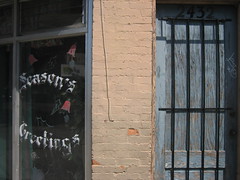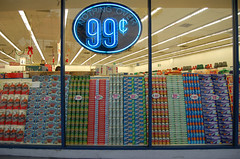Flickr Interlude

Potato
Originally uploaded by Quino Terceño
Part of a nice set, “White Elephant.”

Potato
Originally uploaded by Quino Terceño
Part of a nice set, “White Elephant.”
I happened to notice this item carrying the news that CBS has struck a deal with something called Gas Station TV, “to push programming streams to viewers at gas pumps.”
CBS will deliver a potpourri of breaking news and headlines from CBS News along with short takes from its entertainment programming to a captive audience of consumers while they fill their gas tanks.
Obviously, the payoff is that this programming will also be spiked with ads. I was dimly aware of the idea of television screens at gas tanks, but I’ve never experienced it that I can recall, and I wasn’t aware of this company, which claims that 30 million people a month see programming on its 5,000 gas station screens in 300 cities.
Curious, I found Gas Station TV’s site, where a press release quotes the company CEO saying: “We’re transforming the gas station into a true media destination for consumers, marketers and retailers alike.”
Elsewhere, the site explains the appeal to advertisers of this “media destination”: “GSTV reaches the consumer ‘off the couch’ and ready to take action.” It claims that advertisers can target a “demographic audience based on location and time of day,” and mentions that “your ad is integrated with content,” although that’s not really explained. Also mentioned in a promotional video on the site: it’s a “captive audience,” and there’s no TiVo factor here.
Three things:
First, I stand once again awestruck before the astonishing inventiveness that the profit motive inspires. I would not have imagined the gas pump as a captive-audience venue. And even if I had, I would not have believed that somebody would go to the trouble and expense to create a system to treat it that way.
Second, while assorted gurus continue to make a living peddling the idea that thanks to various technologies (such as TiVo) “interruption marketing” is dead, and in the future we’ll only be exposed to the sales pitches etc. that we the consumer find personally relevant, here, once more, is proof that this assertion is balderdash. What ad-avoiding technology has done is inspire previously unthinkable new forms of interruption, and that’s not going to stop. See point one above.
Third, while my instinct is to be annoyed at the idea of being pitched while pumping gas, I’m having trouble really backing that up. It’s not like a gas station is a public space, like park, or a sidewalk. It’s already a business, so I guess the owners of the business can do whatever they want, and I can choose to be there or move along. And it’s not like I view pumping gas as an enjoyable and relaxing respite from my busy day. It’s not a leisure activity, or a time for private reflection: It’s pumping gas. How outraged can I really be?

Originally uploaded by R. Walker
“Corporations increasingly are attaching their names to holiday traditions across the USA as they vie for attention in a crowded media landscape,” says USA Today, which offers these examples:
•In Virginia Beach, McDonald’s Holiday Lights at the Beach Presented by Verizon Wireless features about 250 animated light displays, including a surfing Santa. The companies, along with other sponsors, finance the attraction.
•In Sioux Falls, S.D, the annual Sioux Falls Parade of Lights this year became the Avera Parade of Lights. The sponsorship by the local health care system enabled organizers to add a 60-foot Christmas tree.
•In Oklahoma City, the Sonic Segway Santa is a big part of the Downtown in December festival. Santa rides a Segway through downtown to promote green transportation and Sonic drive-in food.
The Sonic Segway Santa!
OK. And a happy holiday to you.
Technically this is not in the murketing pool. But this amazingly cool set, “Illustrated Supermarket Signage,” will reward your attention.
 Premium Outlets: How a new-luxury brand manages the dances with the mass market.
Premium Outlets: How a new-luxury brand manages the dances with the mass market.
There was a time when outlet centers were associated with the grubby matter of liquidating unsold merchandise to unglamorous bargain hunters in a low-rent building in the middle of nowhere. Clearly this image has evolved, and many apparel makers even manufacture products specifically for their outlet channels. About 10 years ago, the Chelsea Property Group (a division of Simon Property Group) recognized an opportunity in this low-end category: branding high-end outlet shopping. Today, Chelsea Premium Outlets operates in dozens of locations in the U.S. and abroad, including the sprawling Woodbury Common Premium Outlets, about an hour north of New York City. Current Woodbury tenants include Jimmy Choo, Tory Burch and True Religion….
Continue reading at the NYT Magazine site.
 I know I just signed off with that last post, but one more thing, okay? Theme Magazine, for its issue #12 (“I Want”), asked me to interview Tobias Wong, and that Q&A appears in the magazine’s current issue, and is also online. Theme says:
I know I just signed off with that last post, but one more thing, okay? Theme Magazine, for its issue #12 (“I Want”), asked me to interview Tobias Wong, and that Q&A appears in the magazine’s current issue, and is also online. Theme says:
Consuming Consumer Consumption: ARTIST TOBIAS WONG speaks to murketing.com’s Rob Walker about consumerism, art, and the irritating lure of the iPhone.
The Q&A is here.
I’m ambivalent about Battlestar Galactica, but I do like these posters, via ffffound.
And with that, I wish you a happy holiday. See you later.
All right then. I was pretty pleased at the overall reaction to the Handmade 2.0 story (additional links here), which I’ll shut up about after this post. I’ll return this general subject in the new year, with some new Q&As and so on, but for now I did want to pass along a few final reactions of interest to those who read the story.
Anne Elizabeth Moore, author of Unmarketable and former Punk Planet editor (and Murketing Q&A victim) is currently in Cambodia and writing a great blog about her experiences there, but also took a moment to offer some thoughtful reaction from a DIY veteran point of view. Or to be more precise, a DIY veteran who happens to be learning Cambodian culture. It’s so good I refuse to excerpt it. Read it here.
I was also quite interested in this BlogHer post, which gathers up some interesting tidbits I had missed, and links to the author’s own thoughts (pre-dating my article) on living “at the intersection of craft and Web 2.0.)
This Moop post offers an interesting point of view on one crafter’s relationship with Etsy, and with the ideology of crafting.
I believe I have already noted the one very long thread that came up of reactions to the piece in the Etsy forums. It is here, and as of the moment runs to about 32 pages of comments. There’s also a much shorter thread of reactions in Etsy’s blog/magazine The Storque, right here. Another site with a discussion is the Unofficial Etsy News blog.
Broadly speaking, there’s just too much in these three threads for me to respond to, and my general policy is that while I will always read and am very interested in such reactions, I don’t respond to them. I figure in most cases they are more about people wanting to state a point of view, rather than hear from me. Which I think is fine, and in fact good: I’ve already had my say.
Besides, if somebody wants to ask me something directly — here I am, go ahead.
Other random mentions: Henry Blodget says “gushing.” Counter indicator? Maybe so, given a lot of what’s said in the threads cited above, and that Core77 (which in my view has a better track record than the former stock analyst) says “sober, non-sentimental.” Also: Design*Sponge, How, Good, PSFK, Apartment Therapy, We’ll Know When We Get There (who makes a good point about all the folks trying force community), Then Thousand Places (who writes about the Handmade Pledge), Crafty Kim, Modish, Humane Recipe, and Rubber Nun. In some cases those posts simply quoted one section, or offered a very quick reaction, but I find those kinds of things quite interesting — and much appreciated.
Paul Lukas holds back nothing in this awesome and definitive case against corporate logos on sports uniforms. Highly recommended.
Pantone says the “color of the year” for 2008 is “blue iris.” The decree explains:
Combining the stable and calming aspects of blue with the mystical and spiritual qualities of purple, Blue Iris satisfies the need for reassurance in a complex world, while adding a hint of mystery and excitement.
Let me just underscore: It “satisfies the need for reassurance in a complex world.”
Okay?
[Via Coudal.]
New York Magazine ran a story recently on the redevelopment of the Bowery — all the new luxe hotels or whatever. They had a writer spend one night in an SRO, and the next night at one of said luxe hotels. At the SRO, he encounters a guy named Paulie, who is sweeping up:
This isn’t just redevelopment as usual, Paulie says as he sweeps. That’s because the Bowery isn’t just any neighborhood. “It is like 42nd Street. Like Harlem. Names that mean something. Those places you don’t just rebuild. You’ve got to rebrand them. The Bowery is being rebranded.”
I’m amused that even the guy who sweeps up at a Bowery fleabag is comfortable with “rebranding” as a concept.
I was also amused by the story’s subhead, which refers to the Bowery as “America’s greatest skid row.” I think I missed the issue of Conde Nast Traveller where they ranked all the “skid rows.”

Display is rocking
Originally uploaded by poketo
“99 cent store in silverlake.”
Assessing some new Converse commercials, Ad Rants says they are:
motivating the person viewing them to get off their ass, go buy some Converse kicks and make their mark on the world lest they end up the loser these [ads] allude to. That’s a good thing.
Well, if you don’t mind my asking: Is it okay to get off my ass and make a mark on the world without buying “some Converse kicks”? Is that allowed? Is it possible? Or is buying “some Converse kicks” just part of the package? One of the steps I have to take to avoid being a “loser”? What does being “motivated” to make “a mark on the world” have to do with shopping for a particular brand of sneakers? And why, exactly, is it a “good thing”?
Two quick follow-ups relating to the November 18, 2007 Consumed column on one of my favorite topics, imaginary brands. Brandweek reported recently (I’m still catching up reading) that:
Family Guy will become possibly the first animated show to ever have a beer licensee. In an example of reverse product placement, the Rhode Island-based microbrew will be dubbed Pawtucket Patriot Ale after show patriarch Peter Griffin’s libation of choice. It’s scheduled to appear in liquor stores and specialty outlets next year.
Also, I meant to pass along earlier this startling list of fake companies on Wikipedia. Plenty of inspiration for column subject LastExitToNowhere!